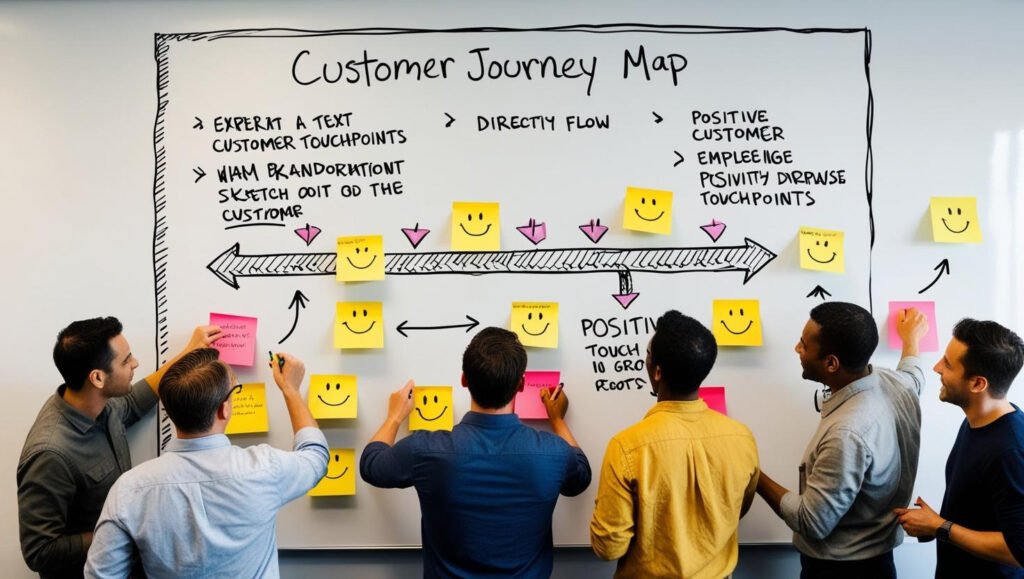Transform Your Business with Customer Journey Mapping
Did you know that businesses using customer journey mapping see a 30% increase in customer retention? This powerful tool shows the paths customers take when they interact with your brand. It goes from the first contact to building long-term loyalty.
Customer journey mapping is a visual guide of every step customers take when they interact with your business. By mapping these interactions, from website visits to in-store experiences, you find ways to improve satisfaction and grow. It points out pain points, makes touchpoints smoother, and aligns strategies with what customers value most.
Key Takeaways
- Customer journey mapping visualizes interactions to enhance experience and retention.
- Mapping uncovers gaps in touchpoints like online checkout or customer service.
- Data-driven insights from mapping inform strategic decisions for better outcomes.
- Tools like Hotjar and UserTesting simplify creating accurate journey maps.
- Businesses using this method report higher satisfaction and sustainable growth.
Understanding Customer Journey Mapping
Customer journey mapping shows how customers interact with your brand at every step. By mapping customer experience, businesses find ways to improve and connect better. This method makes sure every interaction is considered, leading to smarter decisions.
✍️What is Customer Journey Mapping?
Simply put, it’s a visual guide of a customer’s journey from first awareness to loyalty. Companies use customer journey analysis to follow customer actions, feelings, and challenges. This tool ensures strategies match real customer needs, making every interaction a good one.
✍️Visualizing Customer Touchpoints Analysis
- Identify all touchpoints: website visits, in-store visits, customer service calls
- Map emotions at each stage to highlight satisfaction or frustration
- Use heatmaps or flowcharts to visualize high-impact moments
✍️ Key Components in Mapping Customer Experience
| Component | Description |
|---|---|
| Touchpoints | Every interaction point where customers engage with your brand |
| Emotional Journey | Measuring sentiment at each stage to gauge satisfaction |
| Data Integration | Combining surveys, analytics, and feedback for holistic insights |
Enhancing Customer Experience Through Mapping
User journey mapping turns complex customer interactions into clear strategies. It shows each step a customer takes, from first awareness to buying. This helps find ways to make things simpler and less confusing.
Key strategies include:
- Mapping digital and physical touchpoints to identify delays or confusion
- Highlighting moments where customers seek assistance most frequently
- Designing empathy-driven solutions based on real user behavior patterns
| Before Mapping | After Mapping |
|---|---|
| Unclear pain points | Targeted improvements in checkout processes |
| High customer complaints | 30% reduction in support inquiries |
| Generic service approaches | Personalized engagement strategies |
Tools like heatmaps and flow diagrams make complex data easy to understand. Teams can work together better, making sure every interaction meets customer needs. For example, analyzing how users navigate mobile apps can show design flaws that slow down buying.
Small changes can increase sales by up to 20%, as seen in retail and SaaS industries.
Using user journey mapping isn’t just a one-time task. It’s an ongoing process of feedback. By making this a part of daily work, businesses can create better experiences. These experiences turn customers into loyal fans.
Improving Retention and Growth with Customer Journey Analysis
Unlocking opportunities to retain customers starts with analyzing their interactions. By combining customer journey discovery with data-driven customer behavior mapping, businesses can uncover hidden barriers. They can design experiences that keep users engaged long-term.
Identifying Customer Pain Points through Data
Data reveals where customers struggle most. Here’s how to act:
- Track drop-off points in digital funnels to locate friction in the customer journey discovery process
- Use heatmaps and survey feedback to quantify dissatisfaction at key touchpoints
- Align support teams with behavioral data to address issues before they lead to churn
Leveraging Customer Behavior Mapping for Better Retention
Behavior mapping transforms raw data into actionable insights. Consider this comparison:
| Traditional Approach | Data-Driven Approach |
|---|---|
| Assume customers leave due to pricing | Identify via mapping that 68% abandon due to checkout complexity |
| Blanket retention emails | Targeted campaigns based on behavior mapping insights |
| 12% retention rate improvement | 34% retention rate improvement |
Proactive adjustments based on customer behavior mapping reduce guesswork. Companies like Starbucks use real-time journey discovery data to tailor loyalty programs. This cuts churn by 22%. Analyzing the full journey—from initial contact to post-purchase—creates strategies that resonate with actual user needs.
Practical How-To Guide for Customer Journey Mapping
Transform your strategy with actionable steps to map and optimize customer interactions. Our guide breaks down user experience mapping into clear phases. This ensures every step builds a customer-centric roadmap.
✍️ Steps to Map Your Business Interactions
- Identify core customer goals and pain points through surveys and interviews.
- Document every touchpoint—from website visits to customer service calls—using visual timelines.
- Assign metrics like satisfaction scores to quantify journey effectiveness.
- Share insights with teams to align improvements across departments.
✍️ Using User Journey Mapping Tools Effectively
Select the right tools to simplify the process:
- Hotjar: Track digital behavior with heatmaps and session recordings.
- Adobe Experience Cloud: Analyze omnichannel interactions in real time.
- Lucidchart: Build collaborative visual maps for team alignment.
✍️ Best Practices for Customer Journey Implementation
| Practice | Description |
|---|---|
| Start small | Begin with high-impact touchpoints like checkout processes or support calls. |
| Update regularly | Refresh maps quarterly to reflect changing customer behavior. |
| Involve stakeholders | Include frontline teams to validate assumptions and refine insights. |
Pair these steps with continuous feedback loops to ensure your user experience mapping evolves with customer needs. Every adjustment brings your brand closer to seamless, human-centered interactions.
Conclusion
Customer journey mapping is more than a strategy; it’s a path to unlocking business success. By focusing on customer touchpoints analysis, businesses understand how each interaction affects loyalty. This process uncovers service or communication gaps, leading to real improvements.
Every interaction, from first contact to after-sales support, affects customer happiness. By mapping these moments, your brand can meet customer expectations. Companies that do this see better retention, stronger loyalty, and growth in a competitive market.
This guide offers a clear way to begin. Tools like Hotjar or Qualtrics help track customer behavior. Regular reviews of customer touchpoints analysis keep strategies sharp. Every change based on this data brings your business closer to meeting customer needs.
For lasting success, using customer journey insights in decision-making is key. It’s about understanding your audience’s journey, not just following trends. Start by identifying key touchpoints and act on feedback. Small changes can have big effects on customer relationships and revenue.
Businesses that ignore these insights will fall behind. Those who embrace customer journey mapping can anticipate needs, build trust, and turn customers into advocates. The journey begins with mapping, analyzing, and adapting. Your customers’ experiences and your success depend on it.
“No amount of advertising can repair the damage done by failing to properly address a customer’s concern.” – Albert Schindler
FAQ
What is customer journey mapping?
Customer journey mapping is a tool that shows every step a customer takes with our business. It helps us understand how customers interact with us. It also shows us important moments in their journey.
Why is customer journey mapping important for our business?
It’s key because it lets us improve how customers feel about our business. It helps us keep customers coming back and grow our business. We learn what our customers need and how they behave.
How can we identify customer pain points through customer journey analysis?
By analyzing the customer journey, we can find out where things go wrong. We can see where customers face problems. This helps us fix these issues to make customers happier and more loyal.
What tools should we use for effective user journey mapping?
Tools like Lucidchart, Miro, and Smaply are great for mapping the customer journey. They help us see the journey clearly and make our mapping easier.
Can mapping customer experiences lead to increased retention?
Yes! By understanding customer experiences, we can create plans to solve their problems. This makes customers happier and more likely to stay with us.
What are the best practices for customer journey implementation?
To do it well, gather lots of feedback from customers. Keep your maps up to date. Work with different teams to get a full picture of customer interactions.
How does customer behavior mapping contribute to our business strategy?
It gives us deep insights into how customers interact with us. This helps us make smart choices and adjust our plans to match what customers want.
The Future of CX is AI-Powered Customer Support
Struggling with slow responses & high costs? AI-driven CX delivers 24/7 instant support, reduces expenses & improves customer satisfaction…
AI in Customer Support: Top 10 Companies Delivering Next-Gen Service
Discover the top 10 AI customer support companies of 2025 delivering next-gen service, automation, and personalized customer experiences….
AI Customer Support Is Key to Future Revenue
Discover how AI powered customer support boosts revenue with 24/7 service, personalization, and efficiency-transforming customer experience and business growth….
10 Proven Keyword Research Strategies for Higher Google Rankings
Master 10 proven keyword research strategies for higher Google rankings in 2025. Discover tools, competitor analysis, and low-competition keyword tactics…
AI Driven Customer Support: 25 Statistics Every Business Should Know
Unlock 25 key statistics on AI driven customer support and discover how AI is reshaping customer experience, efficiency, and business…
AI Self-Service Solutions: Shaping the Future of Customer Support
Transform customer support with AI self-service solutions. Deliver 24/7 assistance, reduce costs, and boost satisfaction using AI-powered automation and chatbots….











